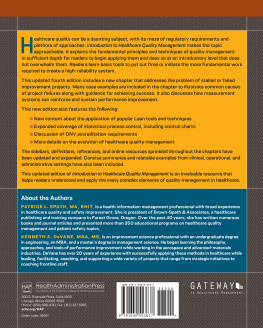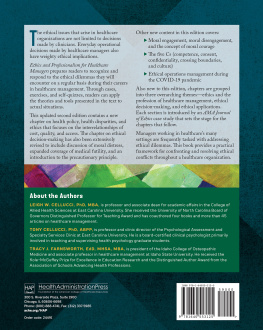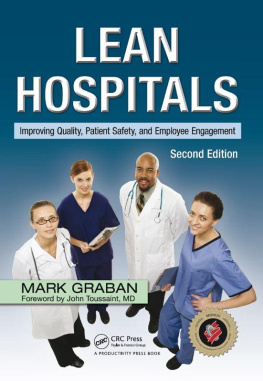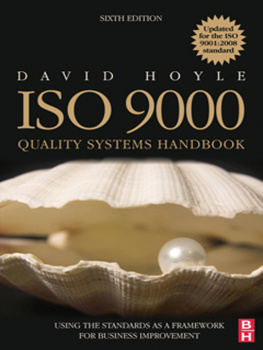Contents
Guide
Pagebreaks of the print version

HAP/AUPHA Editorial Board for Undergraduate Studies
Monica L. Rasmus, DrPH, Chairman
Texas Southern University
Ana A Abad-Jorge, EdD
University of Virginia
Bryan K. Breland, DrPH, JD
University of Alabama at Birmingham
Tina DiFranco
University of Baltimore
Lennox Graham, DM
Howard University
Holly Hampe, DSc
Robert Morris University
Lori Peterson, PhD
Northeastern State University
Jessica L. Ryan, PhD
University of West Florida
Dale L. Sanders, DO, DHA
Alma College
Mark Sciegaj, PhD
Pennsylvania State University
Geoffrey Silvera
Auburn University
James H. Tiessen, PhD
Ryerson University

Your board, staff, or clients may also benefit from this books insight. For information on quantity discounts, contact the Health Administration Press Marketing Manager at (312) 424-9450.
This publication is intended to provide accurate and authoritative information in regard to the subject matter covered. It is sold, or otherwise provided, with the understanding that the publisher is not engaged in rendering professional services. If professional advice or other expert assistance is required, the services of a competent professional should be sought.
The statements and opinions contained in this book are strictly those of the authors and do not represent the official positions of the American College of Healthcare Executives or the Foundation of the American College of Healthcare Executives.
Copyright 2023 by the Foundation of the American College of Healthcare Executives. Printed in the United States of America. All rights reserved. This book or parts thereof may not be reproduced in any form without written permission of the publisher.
262524232254321
Library of Congress Cataloging-in-Publication Data
Library of Congress Cataloging-in-Publication Data is on file at the Library of Congress, Washington, DC. ISBN: 978-1-64055-363-7
The paper used in this publication meets the minimum requirements of American National Standard for Information SciencesPermanence of Paper for Printed Library Materials, ANSI Z39.48-1984.
Acquisitions editor: Jennette McClain; Manuscript editor: Deborah Ring; Project manager: Andrew Baumann; Cover designer: James Slate; Layout: Integra
Found an error or a typo? We want to know! Please e-mail it to , mentioning the books title and putting Book Error in the subject line.
For photocopying and copyright information, please contact Copyright Clearance Center at www.copyright.com or at (978) 750-8400.
Health Administration Press A division of the Foundation of the American College of Healthcare Executives 300 S. Riverside Plaza, Suite 1900 Chicago, IL 60606-6698 (312) 424-2800 | Association of University Programs in Health Administration 1730 M Street, NW Suite 407 Washington, DC 20036 (202) 763-7283 |
This book is dedicated to the thousands of healthcare workers who provide high-quality patient care every day. Your contributions to our health and wellness are much appreciated!
Patrice L. Spath and Kenneth A. DeVane
BRIEF CONTENTS
DETAILED CONTENTS
FOREWORD
W hen I wrote the foreword to the first edition of Introduction to Healthcare Quality Management in 2009, it did not occur to me that I would also write forewords for the second and third editions, and now for the fourth! What a wonderful testimony to the enduring value of this book for health professions students, educators, and working health professionals. Unfortunately, my unscientific study of the number of hits for healthcare quality books/textbooks cant be updated, because Google no longer reports the number of hits for a particular search topic. However, I can report that links to Patrice L. Spaths extant books top the list of retrieved items. I fully expect this comprehensively revised edition to join that listing.
As with previous updates, Spath, along with co-author Kenneth A. DeVane, has updated references, provided new exhibits and teaching resources, and added completely new content. Key terms and definitions, one of the books assets, have been updated to reflect current usage. Words that entered the quality lexicon since publication of the third edition have been incorporated. New application exercises, case studies, and discussion questions will aid faculty in refreshing their courses and encourage students to engage with the new material. Expanded information about the evolution of healthcare quality management also personalizes our history with new information about our gurusJoseph Juran, W. Edwards Deming, and others. Visualizing how quality and safety management approaches advanced with changes in the healthcare system, and the effect of societal influences, will aid in anticipating future directions.
Among the new content is a discussion of the DNV GL-Healthcare hospital accreditation standards and their application in acute care, psychiatric, and critical access facilities. This relatively new accreditation program, which has accredited more than 600 US hospitals, integrates ISO 9001 quality management standards with the Centers for Medicare & Medicaid Services (CMS) Conditions of Participation. DNVs experience in other safety critical industries globally offers promise for transferring their systems and processes into healthcare.
A new chapter, Achieving Sustainable Performance, expands guidance for preventing failed improvement projects. A key section in this chapter provides direction on how to incorporate effective change management principles to reinforce and sustain implemented improvements. The healthcare environment is dynamic as well as complex, and healthcare organizations necessarily must be both to operate effectively. Sustaining desired changes while anticipating and preparing for new changes requires leaders to understand these key principles and to integrate them with regulatory requirements and their organizational context.
Spath and DeVane deliver a comprehensive introduction to the fundamentals of ensuring quality and safety in healthcare organizations, including robust application exercises and examples. They provide guidance for extending the learning from this book through additional references and online resources. Faculty who have used previous editions of the book will enjoy the opportunity to refresh their courses and incorporate new content and resources. Students who are preparing to enter the healthcare workforce will have a good foundation for joining quality and safety improvement teams in their employing organizations and will be well prepared to participate meaningfully. Health professionals will appreciate the examples and descriptions of contemporary projects that have been successfully applied in administrative, operational, and clinical situations to inform their own project planning.
Over the course of my career of more than 45 years, Ive acquired the lived experience of healthcare quality and safety as a student, hospital employee, health professions educator, and consumer. I know firsthand, and from different perspectives, the value of books such as








